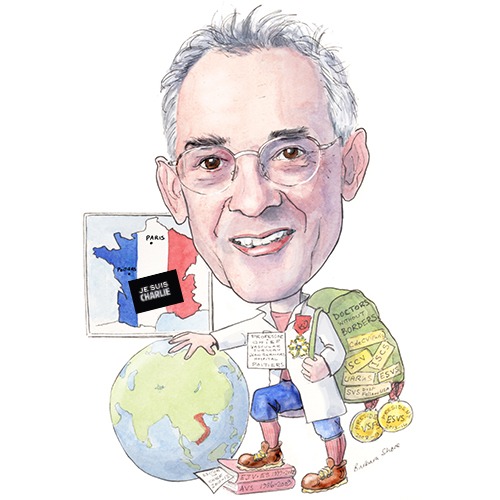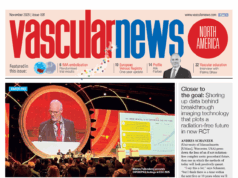
Jean-Baptiste Ricco, head of Vascular Surgery, Hôpital Jean Bernard, CHU de Poitiers, Poitiers, France, is the immediate past-president of European Society for Vascular Surgery (ESVS) and for over 15 years held an editor’s position with the European Journal of Vascular and Endovascular Surgery (which last year achieved its highest impact factor). In this interview, Ricco tells Vascular News about his mentors in vascular surgery, achievements in the ESVS and journal, and his volunteering experience helping patients in areas of conflict—what he calls his “secret garden”. “Donating to people makes you a very rich man and charity medicine is an achievement almost impossible to translate,” he says.
When did you decide you wanted a career in medicine?
I was in college, studying mathematics and physics in a training programme hoping to join l’Ecole Normale Supérieure when I decided to turn to biology and medicine.
Why did you decide to specialise in vascular surgery?
During my residency in the René Descartes University in Paris, I was privileged to be one of the residents of Charles Dubost in Broussais Hospital; it was him who gave me the “vascular virus”.
Who has your greatest influences been and what advice of them you still remember?
Charles Dubost, Jean-Michel Cormier and Édouard Kieffer were my French mentors. While Dubost and Cormier taught me the science of vascular surgery and how to operate, Kieffer explained the importance of writing and publishing. However, I was most influenced by a two-year fellowship in the United States with Dr Bergan and Dr Yao at Northwestern University in Chicago. This was made possible by a grant from the Fullbright Foundation (1982–83). I learnt with them how to run a research programme and how to write a clinical paper. They stressed the need to build a career on clinical research rather than to operate on a patient after patient without much thought.
What have your proudest moments been?
At the very beginning of my medical career, in the late seventies, it was when I successfully joined the internship programme at the University of Paris AP-HP (Assistance Publique des Hôpitaux de Paris). At that time, only 140 residents among 3,800 applicants were selected for an internship in surgery. This was a great opportunity.
How has vascular surgery evolved since you began your career?
New technology changed our speciality in the nineties. We had to learn catheter skills and how to think differently. At the beginning, endovascular and open surgery were complementary; it was a very exciting period.
What have your biggest achievements as president of the European Society for Vascular Surgery (ESVS, 2013–2014) been?
The president of the ESVS has a very limited impact upon the society and a single year is rather short. It takes nearly a year before your ideas come to reality and at that time you are gone.
I did try, however, to work hard with the ESVS council and with the ESVS executives to reshape the society into a solid scientific structure and all who attended the ESVS annual meeting 2014 in Stockholm saw a significant change with high-quality papers and outstanding symposia. During that year, I also tried to get more support from the industry with a balance between science and sessions run with industry support. But one year was really too short to achieve these goals and the next meeting in Porto will show the achievement of all the efforts of our group. The year 2014 was also difficult for the society, as the economic situation was bad and major changes in the administration took place. The new secretary-general to be elected in January will have to face numerous challenges.
You were part of the Editorial Board of the European Journal of Vascular and Endovascular Surgery (EJVES) for many years and editor-in-chief from 2010 to 2013, and recently the journal reached its highest impact factor. What changes have improved the performance of EJVES?
The years as editor-in-chief of the Journal were among the most interesting of my career with a real challenge and one goal: make the journal better. We had a great editorial team with Ross Naylor as senior editor. We worked very closely with daily emails and it was the key to our success. We did not try to improve the impact factor itself, but we improved the quality of the journal with a selection of the best research papers, and the set-up of a committee by Philippe Kolh ready to run all the guidelines that will be published in the following months. This solid organisation will guarantee the high quality of the journal in the coming years beyond the impact factor itself.
You are a “doctor without borders”, can you please tell us some of the interactions you have had when working with other physicians and treating patients in areas of conflict or natural disaster?
This is my “secret garden”. As you know, French doctors and nurses are very keen to work in remote countries and sometimes in very difficult conditions. “Doctors Without Borders” is a generic name or acronym that covers many non-governmental organisations and charities. I have played my part mainly in Asia but others have done much more. As an example, “la chaîne de l’espoir” has built a hospital in Kabul mainly for children with more than 10,000 surgical cases in the last 10 years, including more than 1,000 open-heart surgeries in war conditions. A similar programme was set up in Cambodia after the fall of the Khmer Rouges and in Vietnam, where many French doctors are actively training local surgeons in remote locations and larger hospitals. These groups received the Nobel Peace Prize but above all they paved the way for local physicians to follow. During these years and today still, it has been a great experience to leave my European settings with sophisticated vascular surgery facilities and go back to basics with cases such as children with amputated legs caused by antipersonnel mines whose families cannot afford the cost of a walking prosthesis. Between politics, the commercial angle of medical companies and strategic issues, this is a different job entirely.
You have had an extensive experience treating patients in China, Vietnam and your home country, France—how have these different experiences contributed to the way you practise vascular surgery?
You cannot export your daily experience gained in Europe to these remote countries, but you acquire a different set of priorities when you come back to your home country. It begins in the plane while surrounded by tourists speaking of their experience at a seaside resort where they spent a week ignoring the rest of the world. What is there to say? Donating to people makes you a very rich man and charity medicine is an achievement almost impossible to translate.
At the recent VEITHsymposium in New York you presented results of a study on the concept of angiosome in determining limb salvage. What has this study shown and what is your opinion about the use of the angiosome concept in lower limb revascularisation?
The concept of the angiosome is very appealing and also a fashionable one. Our meta-analysis, along with others, has shown that when feasible, direct revascularisation of the angiosome may improve wound healing and limb salvage. But there are many caveats: all studies until now are observational, and many are retrospective with a lack of comparability between the groups. In addition, many foot ulcers span multiple angiosomes and patency of the plantar arch or perforating arteries of the peroneal artery are not reported in the majority of these studies. Our experience combined with that of Prof Gargiulo’s group in Bologna has shown that direct revascularisation of the angiosome was impossible in many cases. In that situation, indirect revascularisation should be performed because the restoration of blood flow to the trophic lesion through collateral vessels provide acceptable results in terms of healing and limb salvage.
What new technology in the endovascular field are you watching closely and why?
Two areas have a great potential for development. One is the aortic arch, including the ascending aorta, where new technology brought by the industry is moving fast. No doubt that in a few years the endovascular technology will be the gold standard to treat the majority of the aneurysms of the aortic arch. The other field is related to severe limb ischaemia and infrapopliteal artery occlusion. We see more and more frail nonagenarians with gangrene not amenable by bypass or even to angioplasty. The tools are not there yet but I am convinced that we will see a revolution coming from biology, pharmacology and cell research or from a combination of different techniques. I admit that it will take time.
Please tell us about one of your most memorable clinical cases.
This is a very challenging question. I have operated on many patients and each of them is unique. However, I do remember my failures, and patients endangered by a ruptured aneurysm. In cases like these you have a minute to explain to the patient what is happening, but when I manage to save them and once I speak to them again, I always hear how important these few words were for them.
Outside of medicine, what other interests do you have?
I like politics, literature and music. I also enjoy running and hiking. Concerning politics, I do not belong to a party but I have been elected as deputy mayor in my little town of Poitiers where I take care of social problems related to immigration, unemployment and children care. I believe a citizen should be engaged with his city. Furthermore, it is interesting to see how the political fight can be hard and cruel.
With regards to literature, I read almost everything from Shakespeare to Camus or Joseph Conrad including Agatha Christie or Andrea Camilleri. If you miss Youth, Heart of Darkness or The Niger of the Narcissus by Joseph Conrad or King Lear, your understanding of mankind will remain quite limited.
Concerning sports, running is very useful to forget daily problems. When I run, I do not think. Hiking or climbing the mountains around the Mont-Blanc washes your brain from unnecessary material and demonstrates that you are a very feeble animal!
Fact file
University titles and hospital positions
1973 Intern, Hôpitaux de Paris
1980 MD, Faculty of Medicine Paris VI
1980–1981 Assistant clinical chief, Hôpitaux de Paris
1981–1983 Fellow, Vascular Surgery, Northwestern University, Chicago, USA
1982 PhD, Doctor in Sciences, Paris René Descartes
1990 University professor and hospital surgeon
Surgical research positions
1977–1978 Assistant, INSERM U 17, Hôpital Paul Brousse
1982–1983 Clinical fellowship, Northwestern University, Chicago
Teaching
1990 Vascular pathology, CHU de Poitiers
2004–2008 Interregional coordinator, DESC Vascular Surgery
1995 DESC Angiology (West region)
2000 DESS medical law, Université de Poitiers
Other scientific titles
1981 Laureate, Rothschild Foundation, France
1981 Laureate, Fullbright Foundation, USA
1981 Laureate, International College of Surgeons, France
1983–1984 Laureate, Fondation pour la Recherche Médicale, France
1998 Membre, Académie de Chirurgie
2013 Officer, Légion d’Honneur
Associations
1984 Member, Collège de Chirurgie Vasculaire (Paris)
1985 Member, Société de Chirurgie Vasculaire de Langue Française
1987 Member, International Society for Cardiovascular Surgery
1987 Member, Association Universitaire de Recherche en Chirurgie
1995–2000 General secretary, Société de Chirurgie Vasculaire de Langue Française
1996 Member, European Society for Vascular Surgery
2001 Member and distinguished fellow, Society for Vascular Surgery, USA
2003–2007 Treasurer, European Society for Vascular Surgery
2003–2013 Member, Administrative Council and Executive Committee, ESVS
2008-2009 President, Société de Chirurgie Vasculaire de Langue Française
2012–2013 President, European Society for Vascular Surgery
Editorial activities
1986–2009 Associate editor, Annals of Vascular Surgery
1999–2006 Associate editor, European Journal of Vascular and Endovascular Surgery
2007–2010 Senior editor, European Journal of Vascular and Endovascular Surgery
2010–2013 Editor-in-chief, European Journal of Vascular and Endovascular Surgery













